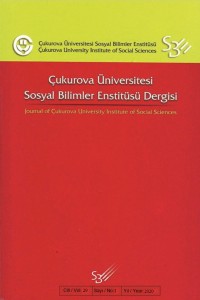Abstract
Doğal gaz
enerjisi; petrol ve kömür gibi birincil enerji türlerine göre sahip olduğu
avantajlı yönleri dolayısıyla dünya ekonomilerindeki enerji politikalarının
belirlenmesi ve uygulanmasında önemli bir rol oynamaktadır. Bu doğrultuda,
sürdürülebilir büyüme ve kalkınmanın sağlanması için ülkelerin doğal gaz
talebine karşı bağımlılık derecesinin de önem arz ettiği ifade edilebilir.
Yapılan çalışmada, 2007-2015 yılları arasındaki Türkiye ile seçilmiş Avrupa
Birliği Ülkeleri’ndeki doğal gaz talebinin konut ile sanayi sektörlerindeki
fiyat ve gelir esnekliğinin tahmin edilmesi amaçlanmıştır. Kurulan modelde yer
alan değişkenler arasındaki ilişki, Panel birim kök testi ve Panel ARDL yöntemi
tahmincisi ile analiz edilmiştir. Yapılan ampirik analiz sonuçları, seçilmiş
ülkelerde konut sektöründeki fiyat esnekliğinin sanayi sektörüne göre nispeten
daha düşük ve konut sektöründe ise gelir esnekliğinin sanayi sektörüne göre
daha yüksek olduğunu ortaya koymaktadır.
Keywords
References
- Baltagı, B.H. (2005), Econometric Analysis of Panel Data, Third Edition, John Wiley Sons Ltd., Chichester,England.
- Baranzini, A., & Weber, S. (2013). Elasticities of gasoline demand in Switzerland. Energy policy, 63, 674-680.
- Berndt, E., & Watkins, C. (1977).Demand for Natural Gas: Residential and Commercial Markets in Ontario and British Colombia”, Canadian Journal of Economics, (10), 97-111
- Bernstein, R., & Madlener, R. (2011). Residential natural gas demand elasticities in OECD countries: An ARDL bounds testing approach. FCN Working Paper No. 15/2011
- Bilgili, F. (2014).Long Run Elasticities of Demand of Natural Gas:OECD Panel Data Evidence, Economics, Planning and Policy, (9), 334-341.
- BP (2017), Statistical Review of World Energy, https://www.bp.com/content/dam/bp/en/corporate/pdf/energy-economics/statistical-review-2017/bp-statistical-review-of-world-energy-2017-full-report.pdf (Erişim Tarihi: 10.05.2018)
- BP (2018), Statistical Review of World Energy, https://www.bp.com/content/dam/bp/en/corporate/pdf/energy-economics/statistical-review/bp-stats-review-2018-full-report.pdf (Erişim Tarihi: 10.06.2018)
- Burke, P. J., & Yang, H. (2016). The price and income elasticities of natural gas demand: International evidence. Energy Economics, 59, 466-474.
- Çatık, A.,& Deliktaş, E. (2016).Türkiye’de Petrol, Kömür ve Doğal Gaz Talebinin Fiyat ve Gelir Esnekliklerinin Tahmin Edilmesi, Pamukkale Üniversitesi Sosyal Bilimler Enstitü Dergisi, Ek 1, 1-20
- Dünya Bankası, (2017), World Development Indicators. http://databank.worldbank.org/data/source/world-development-indicators (Erişim Tarihi: 10.05.2018)
- Eltony, M. N. (1996). Demand for natural gas in Kuwait: an empirical analysis using two econometric models. International journal of energy research, 20(11), 957-963.
- Energy Information Agency (EIA), 2017, https://www.eia.gov (Erişim Tarihi: 15.06.2018)
- Erdoğdu, E. (2010). Natural gas demand in Turkey. Applied Energy, 87(1), 211-219.
- Estrada, J. & Fugleberg, O. (1989). Price Elasticites of Natural Gas Demand in West Germany and France, Journal of Energy, (10), 77-90
- Eurostat (European Statistics), http://ec.europa.eu/eurostat/web/main/home (Erişim Tarihi: 15.05.2018)
- Griffin, J.M. (1979).Energy Conservation in OECD:1980-2000, Ballinger Publishing Company:Cambridge.
- Im, K. S., Pesaran, M. H., & Shin, Y. (2003). Testing for unit roots in heterogeneous panels. Journal of econometrics, 115(1), 53-74.
- Kılınç, N. Ş., (2014).Sanayi sektöründe Enerji Talep Esnekliklerinin Tahmini: OECD Ülkeleri Örneği, Doktora Tezi, Selçuk Üniversitesi, Sosyal Bilimler Enstitüsü:Konya.
- Krichene, N. (2002). World Crude Oil and Natural Gas:A Demand and Supply Model., Energy Economics, (124), 557-576.
- Levin, A., Lin, C. F., & Chu, C. S. J. (2002). Unit root tests in panel data: asymptotic and finite-sample properties. Journal of econometrics, 108(1), 1-24.
- Nilsen, O. B., Asche, F., & Tveterås, R. (2005). Natural gas demand in the European household sector. Working paper No:44/05
- Özdemir, A. (2009). Doğal Gazın; Dünya, Avrupa Birliği ve Türkiye Açısından Önemi Bağlamında Nabucco Projesinin Değerlendirilmesi. Güvenlik Stratejileri Dergisi, 5(10), 83-104
- Öztürk, A.B. (2017), Doğalgaz Sektörü, İktisadi Araştırmalar Bölümü, Ocak, 2017
- Öztürk, S., & Altınöz, B. (2018), İmalat Sektörü Firma Karlılığının Ekonomik Büyüme Üzerindeki Etkisi: Türkiye İçin Bir Uygulama. Ömer Halisdemir Üniversitesi İktisadi ve İdari Bilimler Fakültesi Dergisi, 11(3), 18-25.
- Pindyck, R.S. (1979).The Structure of World Demand. MIT Press: Cambridge.
- Pesaran, M.H., Shin, Y. & Smith, R.J. (1999). “Pooled Mean Group Estim8ation of Dynamic Heterogeneous Panels”. Journal of the American Statistical Association, 94(446).
- Salari, M., & Javid, R. (2016). Residental Energy Demand in United States:Analysis Using Static and Dynamic Approaches, Energy Policy, (98), 637-649.
- Sofuoğlu, E. (2014).Kaya Gazı Devrimi ve Olası Ekonomik Etkileri, Y. Lisans Tezi, Adnan Menderes Üniversitesi, Sosyal Bilimler Enstitüsü: Aydın.
- Sun, C., & Quyang, X. (2016). Price and Expenditure Elasticities of Residental Energy Demand During Urbanization:An Emprical Analysis Based on The Household Level Survey Data in China, Energy Policy, (98), 637-649.
- Tonus, Ö. (2004). Genişleyen Avrupa Birliği’nin Enerji Politikaları ve Türkiye. Gazi Üniversitesi Müzakere Sürecinde Türkiye Avrupa Birliği İlişkileri Uluslararası Sempozyumu, 21-23 Eylül
- Yoo,S., Lim, H., & Kwak J. (2009). Estimating The Residential Demand Function For Natural Gas in Seoul with Correction For Selection Bias, Applied Energy, (86/4),460-465.
- Yorkan, A. (2009), Avrupa Birliği'nin Enerji Politikası ve Türkiye'ye Etkileri, Bilge Strateji, 1(1), 25-41.
- Zhang, Y., Qiang, J., & Fan, Y. (2018). The Price and Income Elasticity of China’s Natural Gas Demand: A Multi-Sectoral Perspective, Energy Policy, (113), 332-341.
Details
| Primary Language | Turkish |
|---|---|
| Journal Section | Research Article |
| Authors | |
| Publication Date | April 20, 2020 |
| Submission Date | May 22, 2019 |
| Published in Issue | Year 2020 Volume: 29 Issue: 1 |

